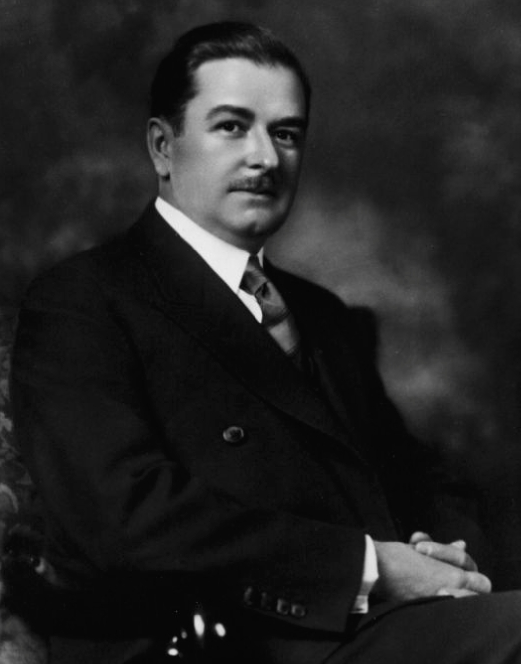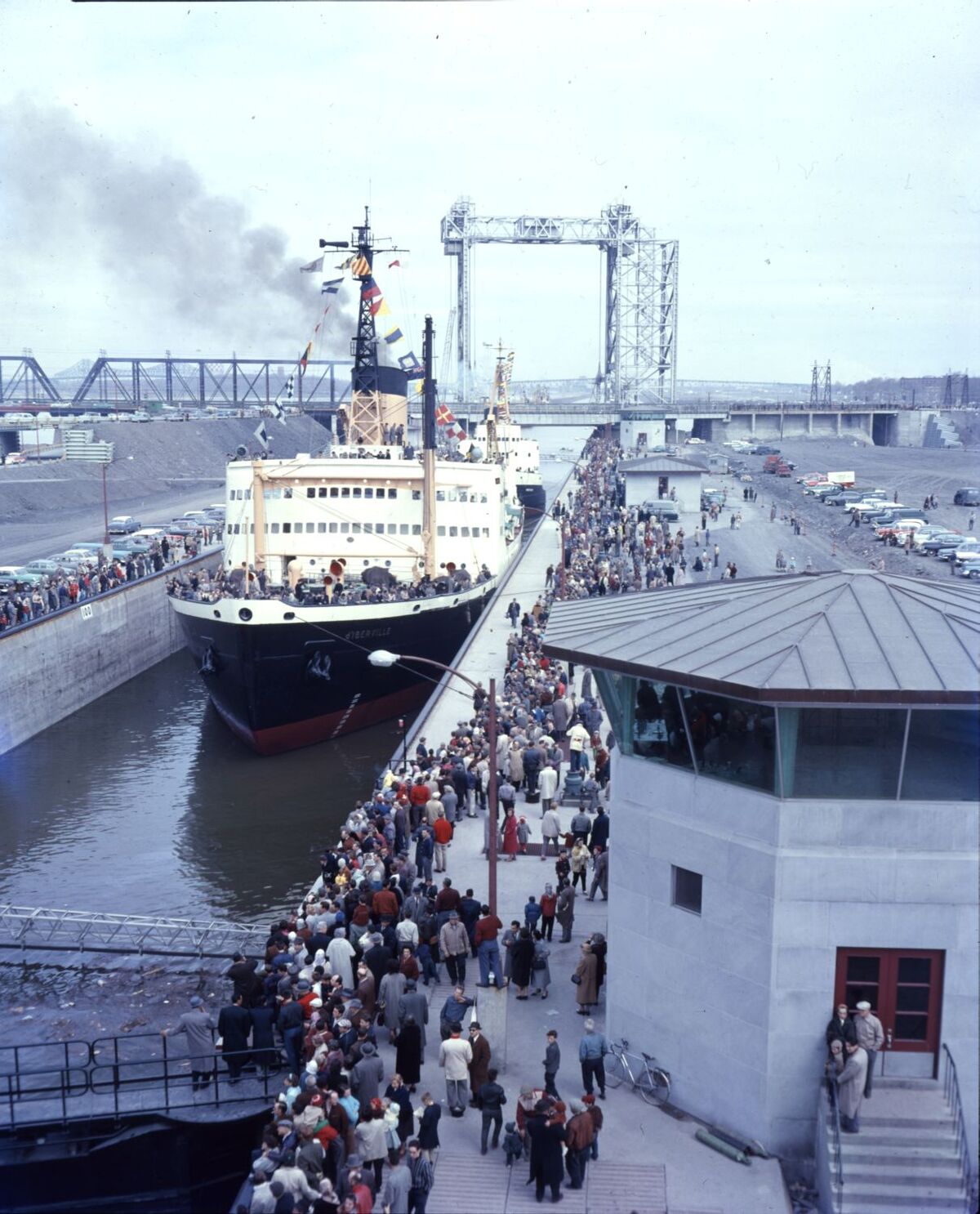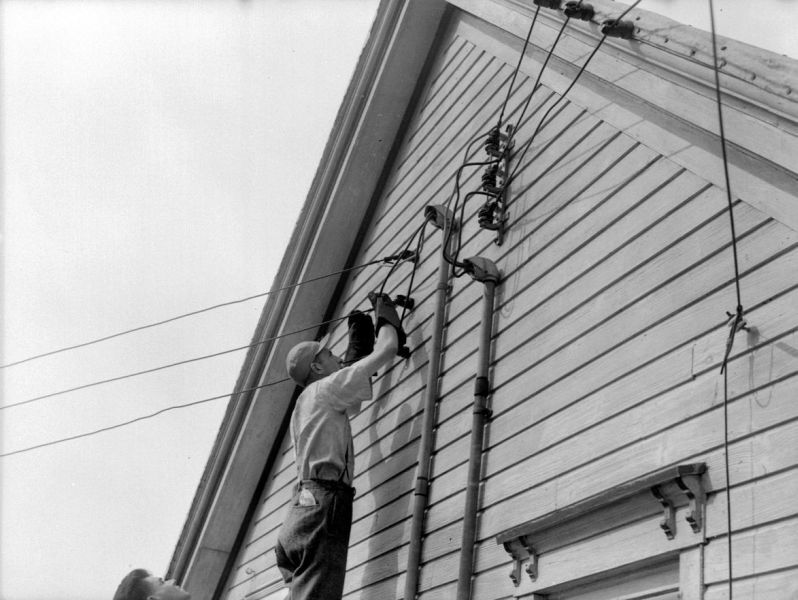Under the Duplessis government, the Quebec economy was growing. In addition to the creation of new transport routes for trade, farms were modernized and regions were increasingly developed largely thanks to electrification. Economic liberalism was favoured by Maurice Duplessis’ government.
Economic liberalism is an ideology that government interventions should be limited. Those who adhere to it consider that the companies must have a lot of flexibility. To do this, the government must adopt as few rules and laws as possible in order to give companies more freedom.

Source: Maurice Duplessis [Photograph], (n.a.), 1938, Bibliothèque et archives nationales du Québec, (URL). Rights reserved*[1]
In this context, there were more and more foreign companies and they had little accountability to the Quebec government. Many of these private companies came from the United States to exploit resources in Quebec, such as ore. In order to exploit these resources, many jobs were created, which was beneficial for Quebec’s economy. The Côte-Nord and Nouveau-Québec regions (located near James Bay and Hudson Bay) were of great interest to mining companies searching for minerals.
However, the presence of foreign companies raised doubts among many opponents of Duplessis, who feared that the profits generated would be at the expense of the province of Quebec. In fact, since many of these companies came from the United States, most of the profits generated by the exploitation of natural resources crossed the border without the province benefiting from them. However, the Premier assured Quebecers that these companies were contributing to the development of the province.
After the end of World War II, the economy of Quebec and Canada experienced a period of growth:
-
Industries needed workers.
-
Municipal services (the construction of road infrastructures) and social services (hospitals, schools, etc.) were developing.
Economic recovery affected all sectors: industries, trade and services.
The increase in consumption brought about changes. The demand for household appliances, cars and daily goods led to an increase in the production of these goods. This resulted in a decrease in unemployment since companies needed more employees to produce more goods. Between 1946 and 1956, the number of jobs in Quebec rose from 357 000 to 446 000. The average salary also went up.
Mining and oil regions were booming, as were industrial cities (such asToronto, Edmonton, Calgary). Transportation in Canada was facilitated by the opening of the St. Lawrence Seaway in 1954, which allowed boats to navigate without interruption from the Great Lakes to the Gulf of St. Lawrence. The canals built during the 19th century were redesigned to accommodate larger ships. Between 1949 and 1962, Canada also invested in the development of a road network. During this period, an 8000-km highway from east to west was built: the Trans-Canada Highway.

The development of the St. Lawrence Seaway was important to allow the passage of larger ships.
Source: Ouverture de la voie maritime du Saint-Laurent [Photograph], Henri Rémillard, April 1959, Bibliothèque et archives nationales du Québec, (URL). Rights reserved*[2]
During the post-war period, the proportion of the population making a living in agriculture was only 11%, with most people living in cities.
The Duplessis government was committed to supporting farmers in the modernization of agriculture. By doing so, it also supported the economic development of the regions. In 1944, the government gave a new incentive to the Ministry of Agriculture, which already existed but saw its responsibilities greatly expanded. This ministry then became a key player in rural electrification, land drainage and access to agricultural credit, which facilitated the financing of agricultural businesses. To protect farmers and improve the marketing of their products, the government created the Office des marchés agricoles in 1956.
Although fewer people were working on the land, more was being produced thanks to technical innovations and mechanization.This increase in output helped farmers make a better living from their land. Plus, the electrification of rural areas gave them access to new tools, including refrigerators, electric lighting and electric motors, which assisted them in their work.

Electrification in the countryside contributed to the development of agriculture.
Source: Office rural d'électrification [Photograph]. Jacques Desjardins, June 1947, Bibliothèque et Archives nationales du Québec, (URL).[3]
The economic development of the regions was facilitated by electrification. In 1945, the Duplessis government began rural electrification. The government invested $12 million to expand access to electricity across the province. Between 1945 and 1955, the percentage of electrified farms in Quebec rose from 19% to 90%.
However, the hydroelectric plants already in place proved insufficient. The Beauharnois power station was rebuilt in 1948, but there was a need for new power stations. To organize hydraulic development, the government created the Ministry of Hydraulic Resources in 1945.
Hydro-Québec is a state-owned company founded in 1944. The first power station, Bersimis-1, was built on the Betsiamites River. It was the first power station installed in northern Quebec. Located north of Forestville, the plant marked the beginning of the development of Côte-Nord. A second plant was inaugurated a little later on the same river: Bersimis-2.
In the 1950s, Hydro-Québec began buying power plants in Abitibi. The state-owned company had developed new technologies to facilitate the transmission of electricity over long distances. It was the first company to install 315 kilovolt high voltage lines over a distance of 600 kilometres. Hydro-Québec enabled Quebec to develop its expertise in the production and transmission of electricity. In 1959, further development on the Manicouagan River and the Outardes River was announced.
The Bas-Saint-Laurent and Gaspésie regions also benefited from hydroelectricity work.
The development of the regions during this period was not limited to electrification. In fact, mining and logging also promoted the development of remote regions. For example, in 1948, the Quebec Iron and Titanium (QIT) company was founded in the Havre-Saint-Pierre region. It continues its activities to this day, north of Havre-Saint-Pierre.
-
(n.a.). (1938). Maurice Duplessis [Photograph]. Bibliothèque et archives nationales du Québec. (URL).*
-
Henri Rémillard. (1959, April). Ouverture de la voie maritime du Saint-Laurent [Photograph]. Bibliothèque et archives nationales du Québec. (URL).*
-
Jacques Desjardins. (1947, June). Office rural d'électrification [Photograph]. Bibliothèque et Archives nationales du Québec. (URL).
*Content used by Alloprof in compliance with the Copyright Act in the context of fair use for educational purposes. [https://laws-lois.justice.gc.ca/eng/acts/c-42/page-9.html].